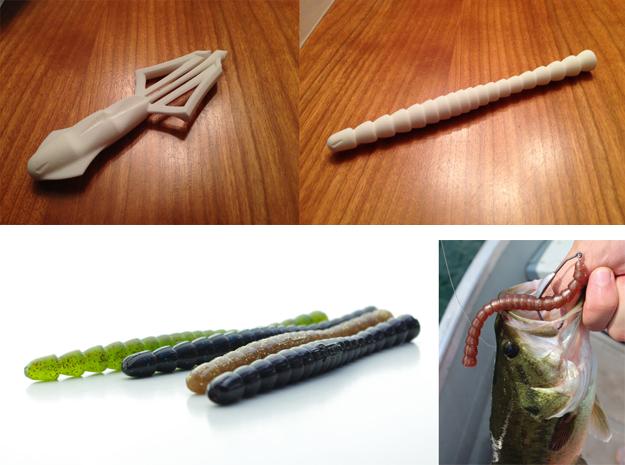One of the major benefits of 3D printing is its capacity to facilitate entrepreneurship, to convert a fledgling cottage industry into a viable competitor in virtually any industry. Whereas a good idea might languish in the idea phase indefinitely because the cost of creating even a working prototype could be prohibitively expensive using conventional manufacturing methods, 3D printing allows for a more cost-effective approach to materializing an ingenious product design. That’s precisely how Shapeways contributor Gabriel Prero got his fishing lure business, BioSpawn Lure Company, from the drawing table to the retail shelf.
Prero, an experienced, full-time industrial designer, and his business partner, an avid bass fisherman, combined their individual expertise to develop the company’s four different soft fishing lures. Prero’s partner had experience with the fishing industry distributing soft lures and observed that the industry could use a serious, more high-tech upgrade.
The partners wanted to use the same low-heat resin, Plastisol, that similar lures were made of, so their lures would be flexible and therefore more lifelike — real enough to convince the bass to bite. They decided they would need to produce molds from which they could create the finished lures. With Plastisol, you can feasibly cast objects using some pretty basic methods in a home workshop. You can make a mold at home, heat up the material in a microwave, pour it into the molds, and voilà! you have your product!
With that home-based, expense-reducing casting process in mind, Prero and his partner sat down and discussed form. What would their lures look like? What qualities did lures already on the market have that made them attractive not only to fishermen (and women), but to the fish themselves?
 Prero, who already knew his way around 3D modeling software, sat down with Solidworks and developed three unique designs for soft lures that he uploaded to Shapeways for 3D printing.
Prero, who already knew his way around 3D modeling software, sat down with Solidworks and developed three unique designs for soft lures that he uploaded to Shapeways for 3D printing.
Once the lures arrived, Prero took the models and, with the use of modeling clay and wood forms, created silicone molds for casting the lures in Plastisol. These first three prototypes were, recalled Prero, “a bit rough,” but they gave the partners something to work with. After that first very small production run, they had to admit that their process was a bit too complicated and imprecise. They had originally thought, explained Prero, to make “Strong White Flexible (SWF) parts of the actual iterations,” but after that first trial, they realized that they could exploit 3D printing in a more efficient way — to print mold-making forms.
It was back to the digital drawing board for Prero, who used Solidworks to split the 3D models, block off the backs, and make mating pegs so that all the partners were required to do was to order the split, mold-ready parts from Shapeways. Once the split forms arrived, they were placed into the pre-made wood forms Prero had built, silicone was poured into them to create the new molds.
This new method yielded much better results. The details they were able to produce were far superior to the earlier lures they’d produced and they’d saved a great deal of time in the process. Now their prototypes were made in the same Plastisol material as similar lures, the ones they were betting on improving upon. They worked their way through around a dozen iterations of the lures, testing and refining, before they arrived at the ones they offer now, having added a fourth soft lure.
Having the actual lures on hand also made it easier for them to turn over the task of creating attractive packaging for their products. After less than a year of launching BioSpawn Lure, their sales are growing. They’ve been picked up by some major on-line retailers in the US as well as abroad and, thanks to some savvy marketing and a high-quality product line, this spring their lures will be available in a large big-box store. While BioSpawn Lure offers a limited line of products at this point, their lures really do have a cool, high-tech appeal and there’s no doubt they’ll be looking for ways to expand their line and their reach.
Do their lures catch your eye? Let us know what you think about BioSpawn Lure’s products and process over in the 3D Printed Fishing Lure Molds forum thread at 3DPB.com.
Subscribe to Our Email Newsletter
Stay up-to-date on all the latest news from the 3D printing industry and receive information and offers from third party vendors.
You May Also Like
Gorilla Sports GE’s First 3D Printed Titanium Cast
How do you help a gorilla with a broken arm? Sounds like the start of a bad joke a zookeeper might tell, but it’s an actual dilemma recently faced by...
Nylon 3D Printed Parts Made More Functional with Coatings & Colors
Parts 3D printed from polyamide (PA, Nylon) 12 using powder bed fusion (PBF) are a mainstay in the additive manufacturing (AM) industry. While post-finishing processes have improved the porosity of...
$25M to Back Sintavia’s Largest Expansion of Metal 3D Printing Capacity Since 2019
Sintavia, the digital manufacturing company specializing in mission-critical parts for strategic sectors, announced a $25 million investment to increase its production capacity, the largest expansion to its operations since 2019....
Velo3D Initiates Public Offering in a Bid to Strengthen Financial Foundations and Drive Future Growth
Velo3D (NYSE: VLD) has been among a number of publicly traded 3D printing firms that have attempted to weather the current macroeconomic climate. After posting a challenging financial report for 2023,...
































